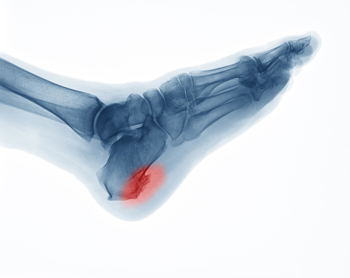
Dr. Kenneth Rosenthal
Dr. Jonathan C. O’Quinn
Dr. Michael J. Price

Dr. Kenneth Rosenthal
Dr. Jonathan C. O’Quinn
Dr. Michael J. Price

Heel spurs are bony protrusions that form on the underside of the heel bone. They can cause intense heel pain, although the spur itself may not always be the direct source of discomfort. Heel spurs do not typically disappear on their own. However, the pain and discomfort they cause can often be managed effectively through various treatments. Treatment primarily focuses on addressing the underlying condition, such as plantar fasciitis, which is often the root cause of heel spur related pain. Common approaches to managing heel spur pain can include rest and stretching exercises to improve foot flexibility. Wearing supportive footwear with adequate cushioning and arch support can alleviate pressure on the heel. Orthotic inserts are often recommended to distribute pressure more evenly. Additionally, anti-inflammatory medications or corticosteroid injections may be used to reduce pain and inflammation. In severe cases, advanced treatments like shockwave therapy may be considered. Surgery to remove the heel spur is reserved for situations where conservative treatments prove ineffective. If you have a heel spur, it is suggested that you schedule an appointment with a podiatrist for an examination, diagnosis, and the best treatment plan for you.
Heel spurs can be incredibly painful and sometimes may make you unable to participate in physical activities. To get medical care for your heel spurs, contact one of our podiatrists from Eastern Carolina Foot & Ankle Specialists. Our doctors will do everything possible to treat your condition.
Heels Spurs
Heel spurs are formed by calcium deposits on the back of the foot where the heel is. This can also be caused by small fragments of bone breaking off one section of the foot, attaching onto the back of the foot. Heel spurs can also be bone growth on the back of the foot and may grow in the direction of the arch of the foot.
Older individuals usually suffer from heel spurs and pain sometimes intensifies with age. One of the main condition's spurs are related to is plantar fasciitis.
Pain
The pain associated with spurs is often because of weight placed on the feet. When someone is walking, their entire weight is concentrated on the feet. Bone spurs then have the tendency to affect other bones and tissues around the foot. As the pain continues, the feet will become tender and sensitive over time.
Treatments
There are many ways to treat heel spurs. If one is suffering from heel spurs in conjunction with pain, there are several methods for healing. Medication, surgery, and herbal care are some options.
If you have any questions feel free to contact our office located in Greenville, NC . We offer the latest in diagnostic and treatment technology to meet your needs.